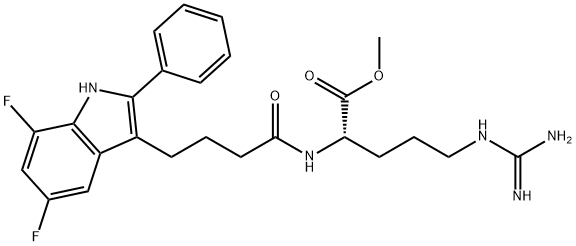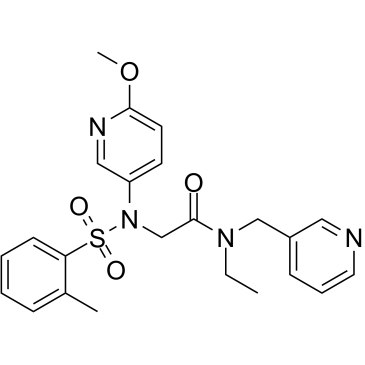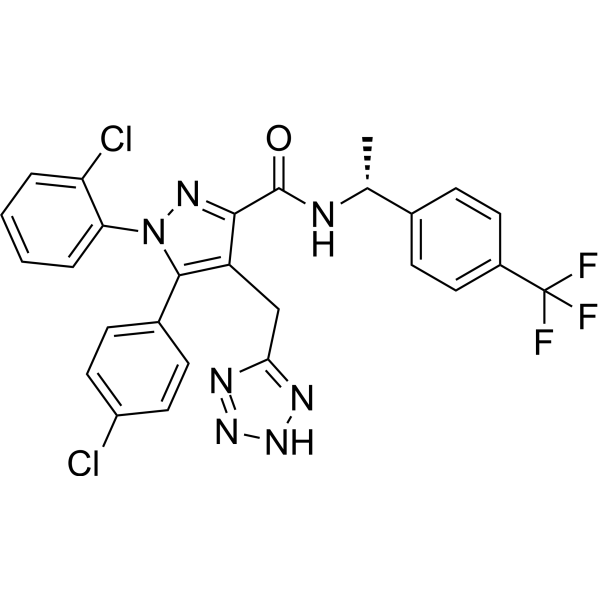| DC28210 |
CYM 9484 |
CYM 9484 is a selective and highly potent neuropeptide Y (NPY) Y2 receptor antagonist with an IC50 value of 19 nM. |

|
| DC28211 |
Naloxone benzoylhydrazone |
Naloxone benzoylhydrazone (NalBzoH) is a mixed agonist/antagonist. Naloxone benzoylhydrazone is a prototypic κ3-opioid receptor agonist, and a partial agonist at the cloned μ and δ opioid receptors, and an antagonist at opioid-like NOP receptors. Naloxone benzoylhydrazone has potently analgesia effect. |

|
| DC28228 |
DG-041 |
DG-041 is a potent, high affinity and selective EP3 receptor antagonist with IC50s of 4.6 nM and 8.1 nM in the binding and FLIPR assay, respectively. DG-041 inhibits PGE2 facilitation of platelet aggregation. DG-041 crosses the blood-brain barrier. |

|
| DC28232 |
CYM50260 |
CYM50260 is a potent and exquisitely selective sphingosine-1-phosphate 4 receptor (S1P4-R) agonist with an EC50 of 45 nM. CYM50260 displays no activity against S1P1-R, S1P2-R, S1P3-R and S1P5-R. |

|
| DC28233 |
CYM 50308
Featured
|
CYM50308 is a potent, selective and high affinity sphingosine-1-phosphate receptor 4 (S1P4-R) agonist with an EC50 of 56 nM. CYM50308 displays 37-fold more selective for S1P4-R than S1P5-R. CYM50308 has no activity at S1P1-R, S1P2-R and S1P3-R subtypes at concentrations up to 25 μM. |

|
| DC28234 |
L-803087
Featured
|
L-803087 is a potent and selective somatostatin sst4 receptor agonist with a Ki of 0.7 nM, which is > 280-fold higher than other somatostatin receptors. L-803087 facilitates AMPA-mediated hippocampal synaptic responses in vitro and increases kainate-induced seizures in mice. |

|
| DC28241 |
L-161982
Featured
|
L-161982 is a selective EP4 receptor antagonist. L-161982 completely blocks PGE2-induced ERK phosphorylation and cell proliferation of HCA-7 cells. L-161982 alleviates collagen-induced arthritis in mice. |

|
| DC28243 |
SHA 68
Featured
|
SHA 68 is a potent and selective non-peptide neuropeptide S receptor (NPSR) antagonist with IC50s of 22.0 and 23.8 nM for NPSR Asn107 and NPSR Ile107, respectively. SHA 68 has limited the blood-brain barrier (BBB) penetration and the activity in neuralgia. |

|
| DC28244 |
NF546 |
NF546 is a selective non-nucleotide P2Y11 agonist with a pEC50 of 6.27. NF546 stimulates release of interleukin-8 from human monocyte-derived dendritic cells. |

|
| DC28245 |
NF157 |
NF157 is a highly selective nanomolar P2Y11 antagonist with a pKi of 7.35. The IC50s are 463 nM, 1811 µM, 170 µM for P2Y11 (Ki=44.3 nM), P2Y1 (Ki=187 µM), P2Y2 (Ki=28.9 µM), respectively. NF157, significantly reduces expression of metalloproteinase (MMP)-3, MMP-13, can be used in the treatment of osteoarthritis (OA). |

|
| DC28246 |
EMPA
Featured
|
EMPA is a high-affinity, reversible and selective orexin OX2 receptor antagonist. [3H]EMPA binds to human and rat OX2-HEK293 membranes with KD values of 1.1 and 1.4 nM respectively. |

|
| DC28248 |
Pasireotide pamoate |
Pasireotide pamoate (SOM230 pamoate) is a stable cyclohexapeptide somatostatin mimic that improves agonist activity at somatostatin receptors (subtypes sst1/2/3/4/5, pKi=8.2/9.0/9.1/<7.0/9.9 respectively). Pasireotide pamoate exhibits antisecretory, antiproliferative, and proapoptotic activity. |

|
| DC28252 |
Seltorexant hydrochloride |
Seltorexant hydrochloride (JNJ-42847922 hydrochloride) is an orally active, high-affinity, and selective OX2R antagonist (pKi values of 8.0 and 8.1 for human and rat OX2R). Seltorexant hydrochloride crosses the blood-brain barrier and quickly occupies OX2R binding sites in the rat brain. |

|
| DC28262 |
PSB-1114 tetrasodium |
PSB-1114 tetrasodium is a potent, enzymatically stable, and subtype-selective P2Y2 receptor agonist with an EC50 of 134 nM. PSB-1114 tetrasodium displays >50-fold selectivity versus the P2Y4 (EC50 of 9.3 μM) and P2Y6 (EC50 of 7.0 μM) receptors. |

|
| DC28268 |
Pregnenolone monosulfate sodium salt |
Pregnenolone monosulfate sodium salt (3β-Hydroxy-5-pregnen-20-one monosulfate sodium salt) is a powerful neurosteroid, the main precursor of various steroid hormones including steroid ketones. Pregnenolone monosulfate sodium salt acts as a signaling-specific inhibitor of cannabinoid CB1 receptor, inhibits the effects of tetrahydrocannabinol (THC) that are mediated by the CB1 receptors. Pregnenolone monosulfate sodium salt can protect the brain from cannabis intoxication. |

|
| DC28279 |
RTI-118 |
RTI-118 is a novel small-molecule neuropeptide S receptor (NPSR) antagonist. RTI-118 can relieve drug addiction including selectively decrease cocaine self-administration. |

|
| DC28285 |
NUCC-390 |
NUCC-390 is a novel and selective small-molecule CXCR4 receptor agonist. NUCC-390 can induce internalization of CXCR4 receptors. |

|
| DC28289 |
HAMI 3379 |
HAMI 3379 is a potent and selective Cysteinyl leukotriene (CysLT2) receptor antagonist. HAMI 3379 has a protective effect on acute and subacute ischemic brain injury, and attenuates microglia-related inflammation. |

|
| DC28290 |
TM38837
Featured
|
TM38837 is a peripheral selective cannabinoid receptor type 1 (CB1) receptor antagonist. TM38837 shows limited penetrance to the brain in order to minimize or prevent CNS adverse reactions, and preserves potential antiobesity effects. TM38837 reduces propensity for psychiatric side effects. |

|
| DC28298 |
cis-Urocanic acid
Featured
|
cis-Urocanic acid is a 5-HT2A receptor agonist. cis-Urocanic acid binds to 5-HT receptor with relatively high affinity (Kd=4.6 nM). cis-Urocanic acid is an immune modulator that induces immunosuppression by binding to the 5-HT2A receptor. |

|
| DC28312 |
Latanoprost acid |
Latanoprost acid, an analog of prostaglandin (PG) F2α, is an selective prostanoid receptor (FP) agonist that specifically activates the FP-PG receptor. Latanoprost acid inhibits RANKL-induced osteoclastgenesis and function by inhibiting ERK, AKT, JNK, and p38 cascade, following by the c-fos/NFATc1 pathway. Latanoprost acid is a medication which works to lower pressure inside the eyes. |

|
| DC28320 |
7α,25-Dihydroxycholesterol
Featured
|
7α, 25-dihydroxycholesterol (7α,25-OHC) is a potent and selective agonist and endogenous ligand of the orphan GPCR receptor EBI2 (GPR183). 7α, 25-dihydroxycholesterol is highly potent at activating EBI2 (EC50=140 pM; Kd=450 pM). 7α, 25-dihydroxycholesterol can serve as a chemokine directing migration of B cells, T cells and dendritic cells. |

|
| DC28321 |
Nebracetam hydrochloride |
Nebracetam hydrochloride, a nootropic M1-muscarinic agonist, induces a rise of intracellular Ca2+ concentration. Nebracetam hydrochloride exhibits an EC50 of 1.59 mM for elevating [Ca2+]i. |

|
| DC28324 |
LPA2 antagonist 2 |
LPA2 antagonist 2 (H2L 5226501) is a selective LPA2 antagonist with an IC50 of 28.3 nM, which is >480-fold more selective than LPA3 (IC50 of 13.85 μM). |

|
| DC28342 |
TD-0212 TFA |
TD-0212 TFA is an orally active dual pharmacology angiotensin II type 1 receptor (AT1) antagonist and neprilysin (NEP) inhibitor, with a pKi of 8.9 for AT1 and a pIC50 of 9.2 for NEP. |

|
| DC28348 |
BMS-248360 |
BMS-248360 is a potent and orally active dual antagonist of both angiotensin II receptor (AT1) and endothelin A (ETA) receptor, with Kis of 10 nM and 1.9 nM for hAT1 and hETA receptor, respectively. BMS-248360 displays hypertensive effects. |

|
| DC28352 |
BMS-470539 dihydrochloride |
BMS-470539 dihydrochloride is a highly potent and selective melanocortin-1 receptor (MC-1R) agonist with an IC50 of 120 nM, an EC50 of 28 nM. BMS-470539 dihydrochloride does not activate MC-3R and is a very weak partial agonist at MC-4R and MC-5R. BMS-470539 dihydrochloride has potently anti-inflammatory properties. |

|
| DC28360 |
(2R,3S)-E1R |
(2R,3S)-E1R (Compound 2c) is an enantiomer of E1R. (2R,3S)-E1R is a sigma-1 receptor positive allosteric modulator (Sig1R PAM) for the treatment of cognition/memory disorders. |

|
| DC28361 |
(2S,3S)-E1R |
(2S,3S)-E1R (Compound 2d) is an enantiomer of E1R. (2S,3S)-E1R is a sigma-1 receptor positive allosteric modulator (Sig1R PAM) for the treatment of cognition/memory disorders. |

|
| DC28362 |
(2R,3R)-E1R |
(2R,3R)-E1R (Compound 2b) is an enantiomer of E1R. (2R,3R)-E1R is a sigma-1 receptor positive allosteric modulator (Sig1R PAM) for the treatment of cognition/memory disorders. |

|





























